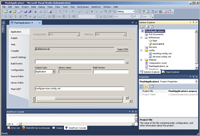Product Reviews
Amethyst and WebOrb Integrate Flash Development with Visual Studio
Well-integrated environment from SapphireSteel lets .NET developers create Flex applications for the Flash platform.
This review got its start in my ToolTracker blog, where I asked if it made sense for VSM to review Amethyst, a Flash (Adobe AIR/Flex) development tool that integrates with Visual Studio. No other blog post last year drew as many comments as that one, and the answer to my question was an emphatic "yes." But, to quote Harry Callahan in the movie "Dirty Harry": "A man's got to know his limitations." While I've dabbled in Flash development, I can't consider myself a Flash developer.
But what I can review is the product's integration -- and it's excellent.
There are actually two components involved. First, there's Amethyst, the SapphireSteel Visual Studio IDE for Action Script and MXML development. Amethyst delivers all of the features that I'd expect to find in a Visual Studio environment: IntelliSense, runtime debugging, refactoring, templates, Solution Explorer integration and more. Second, there's the integration with the Midnight Coder WebOrb runtime environment that allows you to debug your Flex application from within Visual Studio. Again, I found everything that I expected in a Visual Studio debugging environment.
The toolbox for MXML components displays all the controls you might want to drag into an MXML design. You can also import components from existing Amethyst projects and, through WebOrb, existing services (WebOrb generates all the necessary integration code). While I tested it with Visual Studio 2010, the package also supports Visual Studio 2008.

[Click on image for larger view.] |
| Figure 1. The Amethyst integration with Visual Studio extends to the Options dialog box and the property pages for your application. |
The installation process for Amethyst and its WebOrb extension is done entirely from within Visual Studio, though I had to download and install WebOrb separately. The biggest problem: When I pressed F5 to start debugging, Amethyst couldn't find my copy of Flash.exe. However, the error message identified the problem and directed me to the Tools | Options setting that I needed to change.
You can download Amethyst by itself for $249, which gives you the IDE. The WebOrb integration component adds another $149 to that price, for a total of $398 for the pack-age (WebOrb itself, in either the Development Mode or Community Edition, is free).
If you're using Visual Studio 2010 and you're also doing Flash development, the two products are a worthwhile investment. With them, you'll have one less development environment to deal with.
WebOrb and Amethyst IDE Plug-In for Visual Studio
SapphireSteel Software
Web: sapphiresteel.com
Price: $398
Quick Facts: An ActionScript/MXML development and debugging environment for Flash, integrated with Visual Studio
Pros: Virtually full integration with Visual Studio
Cons: None
About the Author
Peter Vogel is a system architect and principal in PH&V Information Services. PH&V provides full-stack consulting from UX design through object modeling to database design. Peter tweets about his VSM columns with the hashtag #vogelarticles. His blog posts on user experience design can be found at http://blog.learningtree.com/tag/ui/.